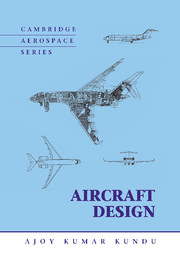Book contents
- Frontmatter
- Contents
- List of Symbols and Abbreviations
- Preface
- Road Map of the Book
- 1 Introduction
- 2 Methodology to Aircraft Design, Market Survey, and Airworthiness
- 3 Aerodynamic Considerations
- 4 Aircraft Classification, Statistics, and Choices for Configuration
- 5 Aircraft Load
- 6 Configuring Aircraft
- 7 Undercarriage
- 8 Aircraft Weight and Center of Gravity Estimation
- 9 Aircraft Drag
- 10 Aircraft Power Plant and Integration
- 11 Aircraft Sizing, Engine Matching, and Variant Derivative
- 12 Stability Considerations Affecting Aircraft Configuration
- 13 Aircraft Performance
- 14 Computational Fluid Dynamics
- 15 Miscellaneous Design Considerations
- 16 Aircraft Cost Considerations
- 17 Aircraft Manufacturing Considerations
- Appendix A Conversion
- Appendix B International Standard Atmosphere
- Appendix C Aerofoils
- Appendix D Case Studies
- Appendix E Tire Data
- References
- Index
11 - Aircraft Sizing, Engine Matching, and Variant Derivative
Published online by Cambridge University Press: 05 June 2012
- Frontmatter
- Contents
- List of Symbols and Abbreviations
- Preface
- Road Map of the Book
- 1 Introduction
- 2 Methodology to Aircraft Design, Market Survey, and Airworthiness
- 3 Aerodynamic Considerations
- 4 Aircraft Classification, Statistics, and Choices for Configuration
- 5 Aircraft Load
- 6 Configuring Aircraft
- 7 Undercarriage
- 8 Aircraft Weight and Center of Gravity Estimation
- 9 Aircraft Drag
- 10 Aircraft Power Plant and Integration
- 11 Aircraft Sizing, Engine Matching, and Variant Derivative
- 12 Stability Considerations Affecting Aircraft Configuration
- 13 Aircraft Performance
- 14 Computational Fluid Dynamics
- 15 Miscellaneous Design Considerations
- 16 Aircraft Cost Considerations
- 17 Aircraft Manufacturing Considerations
- Appendix A Conversion
- Appendix B International Standard Atmosphere
- Appendix C Aerofoils
- Appendix D Case Studies
- Appendix E Tire Data
- References
- Index
Summary
Overview
Chapter 6 proposes a methodology with worked-out examples to conceive a “firstcut” (i.e., preliminary) aircraft configuration, derived primarily from statistical information except for the fuselage, which is deterministic. A designer's past experience is vital in making the preliminary configuration. Weight estimation is conducted in Chapter 8 for the proposed first-cut aircraft configuration, revising the MTOM taken from statistics. Chapter 9 establishes the aircraft drag (i.e., drag polar), and Chapter 10 develops engine performance. From these building blocks, finally, the aircraft size can be fine-tuned to a “satisfactory” (see Section 4.1) configuration offering a family of variant designs. None may be the optimum but together they offer the best fit to satisfy many customers (i.e., operators) and to encompass a wide range of payload-range requirements, resulting in increased sales and profitability.
The two classic important sizing parameters – wing-loading (W/S) and thrust loading (TSLS/W) are instrumental in the methodology for aircraft sizing and engine matching. This chapter presents a formal methodology to obtain the sized W/S and TSLS/W for a baseline aircraft. These two loadings alone provide sufficient information to conceive of aircraft configuration in a preferred size. Empennage size is governed by wing size and location on the fuselage. This study is possibly the most important aspect in the development of an aircraft, finalizing the external geometry for management review in order to obtain a go-ahead decision for the project.
- Type
- Chapter
- Information
- Aircraft Design , pp. 371 - 386Publisher: Cambridge University PressPrint publication year: 2010



